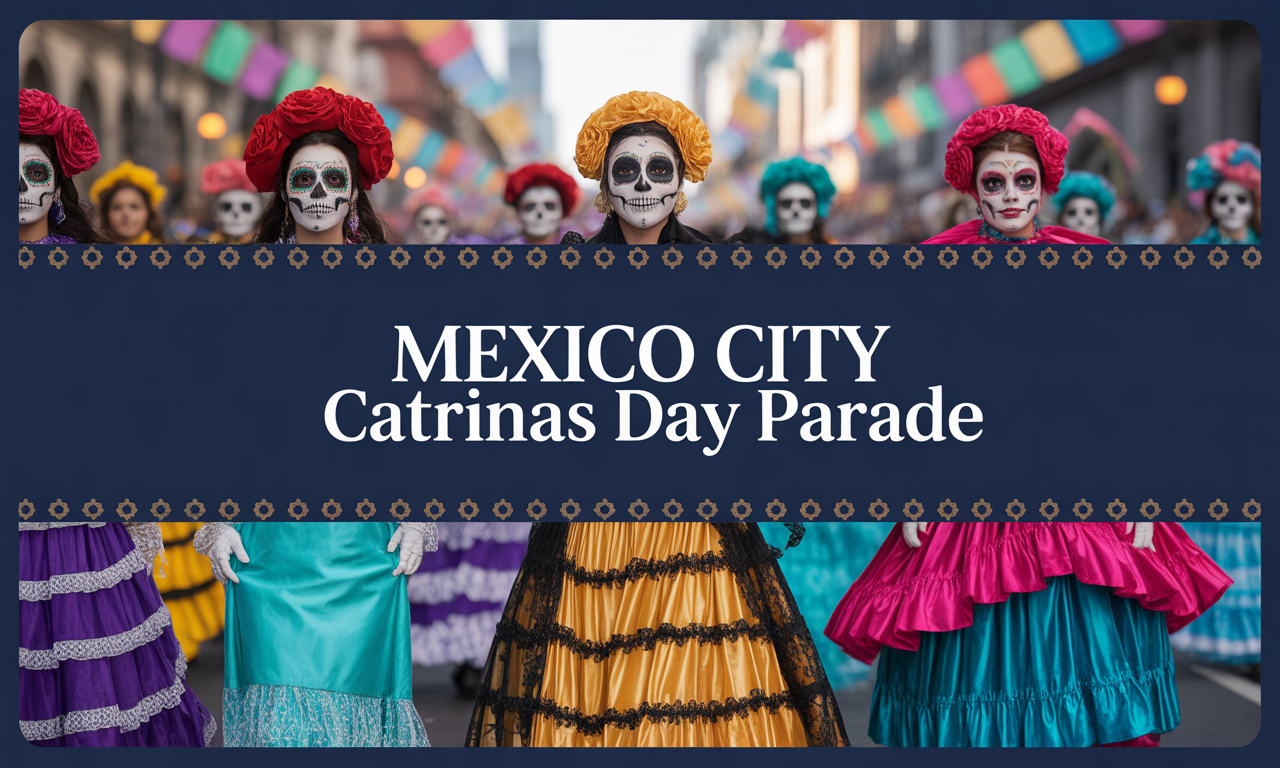Vibrant Faces on Parade: Mexico City’s Annual Catrinas Day Celebration
Intermediate | November 7, 2025
✨ Read the article aloud on your own or repeat each paragraph after your tutor.
A Feast of Colour and Culture in the Mexico City Catrinas Day Parade
Tradition Meets Celebration
On October 26–27, 2025, thousands of costumed participants and spectators filled the streets of Mexico City for the annual Catrinas Day Parade—held in the lead-up to the major holiday Day of the Dead (Día de Muertos). (Reuters) The parade featured people dressed as the elegant skeleton figure known as La Calavera Catrina, a symbol deeply rooted in Mexico’s cultural traditions and reinterpretation of mortality and life. (Wikipedia)
Art, Identity, and Inclusion
The parade blended historic symbolism with modern expression as participants painted their faces like skulls, wore lavish costumes, and marched through the city centre while crowds cheered and snapped photos. (AP News) For many, it was more than a colourful spectacle. The event became a platform for diverse groups—including LGBTQ+ artists—to reclaim space, celebrate identity, and honour heritage. The spirit of the parade was one of joy, remembrance, and inclusion, transforming the streets into a vibrant living artwork.
Lessons for Professionals and Learners
For business professionals and English learners, this celebration offers more than a cultural curiosity. It demonstrates how a traditional holiday can evolve into a large-scale event that attracts global tourism, boosts local economies, and reinforces community pride. Understanding such cultural expressions can help professionals engage more effectively in international markets, where sensitivity to tradition and identity is often key to building trust and connection.
The Timeless Symbol of La Catrina
The figure of La Catrina, first created by Mexican artist José Guadalupe Posada in the early 1900s, began as a social satire—a commentary on class and vanity. Over the decades, it has transformed into a national icon of both remembrance and joy, reminding participants to laugh at death and celebrate life. In Mexico City, that spirit fills the air as bands play, families gather, and tourists join locals in honouring those who came before them. The event, now an annual highlight on the city’s calendar, shows how tradition and modern creativity can walk hand in hand.
Vocabulary
- Reveler (noun) – a person who enjoys and participates in lively festivities.
Example: The revelers at the parade cheered and danced in skeleton costumes. - Spectator (noun) – someone who watches an event.
Example: Hundreds of spectators lined the streets for the parade. - Costume (noun) – a set of clothes worn to represent a character or theme.
Example: Many participants wore elaborate costumes inspired by La Catrina. - Symbolism (noun) – the use of symbols to represent ideas or qualities.
Example: The skull face paint carried deep symbolism related to life and death. - Platform (noun) – a place or means for someone to express themselves.
Example: The parade became a platform for different identity groups. - Heritage (noun) – traditions, values, and culture passed down through generations.
Example: Celebrating Day of the Dead is part of Mexican heritage. - Inclusive (adjective) – embracing diversity and allowing participation from many groups.
Example: The event was inclusive, welcoming artists of all backgrounds. - Spectacle (noun) – a visually striking performance or show.
Example: The parade was a real spectacle of colour and creativity. - Boost (verb) – to increase or improve something.
Example: The parade helped boost tourism in the city. - Platform (verb) – to give someone the opportunity to express themselves.
Example: The parade platformed emerging designers.
Discussion Questions (About the Article)
- What elements made the Catrinas Day Parade both a cultural tradition and a modern event?
- How did participants use costumes and symbolism to express identities?
- Why is this parade relevant for professionals working in international business or communication?
- What role does heritage play in shaping a city’s event strategy?
- How can events like this become platforms for inclusion and expression?
Discussion Questions (About the Topic)
- Have you ever attended or seen photos of a cultural parade in your country? What struck you?
- How important is it for global professionals to understand local traditions when working internationally?
- In what ways can a city’s cultural event influence its image and economy?
- How might costume and symbolism help convey messages beyond words?
- What are some examples of traditions being updated or reinterpreted in your own culture?
Related Idiom
“Steal the show” – to attract the most attention or admiration in a performance or event.
Example: At the parade, the performers in dramatic La Catrina costumes really stole the show—and made the event memorable.
📢 Want more practical English tips like this? 👉 Sign up for the All About English Mastery Newsletter! Click here to join us.
Want to finally master English but don’t have much time? Mastering English for Busy Professionals shows you how to improve in just 10 minutes a day.
Follow our YouTube Channel @All_About_English for more insights and tips!
This article was inspired by: Reuters, AP News, and Wikipedia


